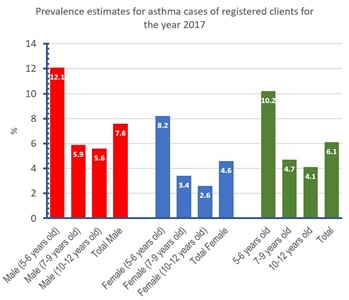A Research Study on Asthma - Dr. Ahmed Sameer Alnuaimi

Asthma is one of the most common chronic diseases with a varying age of onset, affecting all age groups. Recent reports indicate an increasing prevalence especially among children. According to Global Asthma Report around 430 million people are projected to have Asthma by the year 2025. Asthma is reported in about a fifth of children in Qatar.
The introduction of electronic medical recording system (CERNER) in Primary Health Care Corporation (PHCC) in Qatar in 2016 provided a convenient opportunity for researchers to analyze a wealth of data on health status of PHCC service users and their utilization of health care services provided. It is also known that childhood asthma is a growing problem and a burden on the health care system and this was the motivating factor to do some research about Asthma in a primary health care setting.
Anonymized data on 54,704 clinical visits for children with asthma aged 5 to 12 years was analyzed. Two original research articles were written and published in two international journals. The first one was published in Asthma Research and Practice that belongs to the prestigious group BioMed Central (BMC)-Springer Nature. The second one is in Q-Science Connect journal.
First study: Epidemiology and utilization of primary health care services in Qatar by asthmatic children 5–12 years old: secondary data analysis 2016–2017
Authors: Shajitha Thekke Veettil and Ahmed Sameer Alnuaimi
The objective of the research was to measure the magnitude of asthma among children 5-12 years old over the period 2016–2017. In addition, the paper assessed the frequency and pattern of use of the primary care services for children with asthma. The paper used a cross sectional study design.
The prevalence rate of asthma out of total registered children in the specified pediatric age group (5-12 years) was 6.1%. The rate was highest (10.2%) in youngest age group (5–6 years old) and lowest (4.1%) in early adolescence (10–12 years old). Clinic visits for those asthma cases peaked in Oct and Nov, during which the work load for asthma in PHCC clinics is increased by more than 50% compared to the monthly average.
The paper concluded that asthma constitutes an important part (8.5%) of the total primary care clinic workload among children aged 5–12 years (Figure 1). It also stated that steroids medication for asthma, which are essential drugs are under used in primary health care. More studies are needed to understand the barriers for this suboptimal use of steroids medication (steroids being bad for health is a strong believe in the community) especially as a preventive strategy to decrease the frequency of acute attacks of Asthma requiring emergency care visit and reduce the workload in Primary Health Care Centers

Figure 1: Prevalence rate of asthma out of total registered children in the specified pediatric age group
Second study: Association between body mass index (BMI) and asthma in children 5-12 years old: A case-control study using electronic medical records in primary health care corporation, Qatar 2016-2017.
Authors: Shajitha Thekke Veettil and Ahmed Sameer Alnuaimi
Publisher: Hamad bin Khalifa University Press (HBKU Press)
Journal: Q-Science Connect
It was observed over the last several decades that obesity and asthma prevalence have both increased among children. Most epidemiological studies propose that obesity at infancy and early childhood increases the risk of asthma in children.
A case-control study was done on electronic health records for children aged 5 to 12 years who visited one of the Primary Health Care Corporation health centers during the two years study period between 2016 and 2017. A total of 9,889 children with a diagnosis of asthma and valid Body Mass Index (BMI is a standardized measure for body weight by adjusting it to body height) measurement were included in the cases group and an identical number of children who visited the health centers for other reasons and had valid BMI measurements were randomly enrolled in the control group.
The study showed that obesity was significantly more frequent among asthmatics (24.9%) compared to non-asthmatic controls (17.7%). Having asthma, significantly increased the risk of being obese both using simple analysis and complex mathematical modelling (controlling for the possible effect of age, gender and nationality on the association between obesity and asthma).
In conclusion, the current observational study based on a large sample of 5-12 years old children documented a strong association between asthma and obesity. This positive association between asthma and obesity was stronger among older children, females and the native people with Qatari nationality. One of the possible implications for this study is on school health programs to foster engagement of children in physical exercise and healthy food at school to reduce obesity and Asthma.